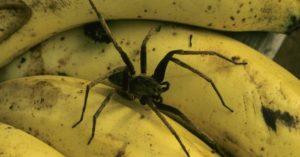Spiders in bananas: a surprise in a bunch of fruits
There are very few people who do not like tender and sweet bananas. These tropical fruits have long been a staple, along with local apples. But, not all banana lovers know that a dangerous banana spider can be waiting for them inside a bunch of their favorite fruits.
Content
What does a banana spider look like
Description of the banana spider
Name: banana spider
Latin: Banana spidersClass: Arachnida - Arachnida
Squad: Spiders - Araneae
Family: Traveler - Phoneutria
 | Habitats: | humid warm places |
 | Dangerous for: | small insects |
 | Attitude towards people: | harmless, harmless |
The banana spider is one of the representatives of the genus of wandering spiders or Phoneutria, which means "killers" in Latin.
This group of arachnids is considered the most dangerous and all species are endowed with extremely toxic poison.
The banana spider also has another, less well-known name, the wandering soldier spider. This species got its name due to its courage and aggressiveness. In case of danger, representatives of this species never flee.
Even if the enemy is dozens of times larger than the spider itself, the brave "soldier" will remain in front of him and take up a fighting position. In this position, the spider stands on its hind legs, and raises its upper limbs high up and begins to sway from side to side.
Its more popular name, the banana spider, derives from its tendency to make its nests in banana palms. The habitat of this species is limited to the tropical forests of South and Central America, and the wide world became aware of a dangerous spider only thanks to individuals traveling inside banana bundles.
Often in bunches of bananas travel also brazilian wandering spiders.
What does a banana spider look like
The body and legs of the wandering soldier spider are quite powerful. The length of a banana spider, taking into account the straightened limbs, can reach 15 cm. The cephalothorax, abdomen and legs are covered with thick, short hairs, painted in gray or brown.
Chelicerae most often stand out against the background of the rest of the body and the hairline on them has a reddish tint. On the legs and upper side of the abdomen, there may be various patterns in the form of rings and stripes.
Features of the reproduction of a banana spider
After the males find a suitable female, they try to attract her attention with a special "courtship dance". After mating, the males try to move away from the female as soon as possible, because otherwise they risk being eaten. 15-20 days after fertilization, the female lays about 3 thousand eggs in a prepared cocoon and carefully guards them until hatching.
Banana spider lifestyle
Dangerous banana spiders never make a permanent home for themselves, as they lead a nomadic lifestyle. Soldier spiders hunt exclusively at night. This species is extremely aggressive and rarely hunts from ambush.
As soon as a potential victim enters the field of view of a banana spider, it rapidly approaches it and immobilizes it with the help of poison.
It is also worth noting that the soldier spider is not at all afraid of people and if a person tries to approach him, most likely he will try to attack.
Soldier Spider Diet
Representatives of this species feed on almost any living creature that they can overcome. Their diet includes:
- large insects;
- other spiders;
- lizards;
- snakes;
- reptiles;
- amphibians;
- rodents;
- small birds.
Natural enemies of the banana spider
The banana spider has few enemies in the wild. A serious threat to them and to other representatives of the genus of wandering Brazilian spiders is:
- wasp tarantula hawk;
- large rodents;
- predator birds;
- some amphibians.
How dangerous is the bite of a banana spider
Banana spider venom contains very dangerous toxins that cause paralysis of the victim. The bite of a soldier spider poses a serious threat not only to health, but also to human life, and can lead to the following consequences:
- severe pain and swelling;
- breathing problems;
- dizziness and loss of consciousness;
- tachycardia and pressure surges;
- numbness of limbs;
- convulsions and hallucinations.
An adult, healthy person with strong immunity can be saved if you seek medical help in a timely manner and administer an antidote. But, for people prone to allergic reactions and young children, the bite of a soldier spider can be fatal.
banana spider habitat
This type of arachnid prefers to settle in tropical rainforests with dense vegetation. The natural habitat of wandering soldier spiders is:
- northern Argentina;
- central and southern states of Brazil;
- some areas of Uruguay and Paraguay.
Interesting facts about banana spiders
- The soldier spider can make what are known as "dry" bites. This refers to cases when a dangerous spider bit a person, but did not inject poison. Not all species of arachnids are able to control the injection of poison when they bite and do similar things.
- One of the effects of a banana spider bite can be priapism. This is the name of a long and very painful erection in men. Some of the “victims” of the soldier spider claimed that thanks to the bite, their intimate life became better, but, of course, there is no documentary evidence of this.
- In 2010, the wandering soldier spider entered the Guinness Book of Records as the most venomous arachnid.
Conclusion
Many residents of regions with a temperate and cold climate dream of living in hot tropical countries. But, it is worth considering the fact that it is in the tropical climate that the most dangerous and poisonous snakes, spiders and insects live next to people.
Previous
